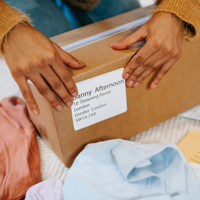How to Protect Shipping Labels from the Elements During Transit
 Printing shipping labels online can save you a great deal or time and money, but when you print shipping labels yourself, you end up being responsible for packing your parcels and making sure shipping labels are properly attached. One of the things you absolutely must do is protect the shipping label from the elements to keep it intact and scannable during transit.
Printing shipping labels online can save you a great deal or time and money, but when you print shipping labels yourself, you end up being responsible for packing your parcels and making sure shipping labels are properly attached. One of the things you absolutely must do is protect the shipping label from the elements to keep it intact and scannable during transit.
Packages aren’t delivered from the post office to their final destination directly. On their way, they pass through multiple sorting facilities, and their shipping labels are scanned at each facility to keep track of their movements. When a shipping label gets damaged to the point of being unscannable, the package may be returned to the sender (if the sender’s name and address are still identifiable) or even get lost.
This is why it is important to do everything you can to protect your shipping labels from the elements and ensure that they stay undamaged and scannable, especially when you’re shipping internationally because an international shipping label is also a customs declaration; without it, your package won’t get cleared by customs.
Shipping labels issued by carriers at a post office are usually printed on special adhesive paper. However, most people who print shipping labels at home don’t bother with buying a special printer and other supplies for adhesive labels. While it’s totally okay because the whole point of online label printing services is to make the process as uncomplicated as possible, it’s important to make sure that shipping labels printed on regular paper are securely attached to the package and protected from the elements.
The best way to protect a shipping label is to get an address pouch. An address pouch is a clear plastic envelope designed to protect your shipping label from damage and ensure that it stays readable. Address pouches come in different sizes and can be self-adhesive to make it easier to securely affix them to a box.
Many carriers supply self-adhesive water-resistant address pouches free of charge; you can typically get them from the carrier’s online store. We recommend against using a random plastic envelope or a sheet protector instead of an address pouch because it may have a reflective service that can make it harder to scan the barcode on the shipping label. Address pouches supplied by carriers are non-reflective to ensure barcodes remain scannable.
But what if you haven’t thought about getting an address pouch and your package is already packed and can’t wait? Luckily, there are other ways to protect the shipping label during transit. For example, you can cover it with clear packing tape. Tape over the entire area of the label except for the barcode; since tape is reflective, it can make the barcode harder to scan. Be very careful and make sure there are no creases.
We also recommend printing a backup shipping label and putting it inside the package. If the shipping label affixed to the package gets lost or damaged beyond readability, the backup shipping label may help the package to get to its destination or at least get returned to the sender instead of getting lost altogether.
Besides protecting the shipping label from the elements, you need to make sure it stays scannable. Although most carriers have structured their barcodes in such a way that they can endure some damage, you should do everything you can to ensure the shipping label is in mint condition.
Once you’ve printed the label, make sure it isn’t too pale. If it is, buy a new cartridge or use another printer. You also need to ensure there are no smudges or smears, especially on the bar code. When you affix the label to the shipping box, be careful to prevent the formation creases or wrinkles. You also shouldn’t wrap the label over the edge of the box; if the label is too big for the largest side of the box, you should print another one that is sized appropriately.